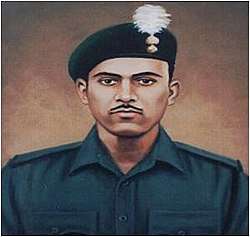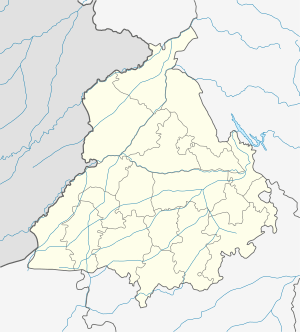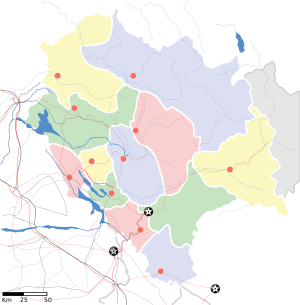Abdul Hamid (soldier)
| Company Quartermaster Havildar Abdul Hamid PVC | |
|---|---|
 | |
| Born |
1 July 1933 Dhamupur, Ghazipur district, United Provinces, British India |
| Died |
10 September 1965 (aged 32) Chima, Khem Karan, Tarn Taran district, Punjab, India |
| Allegiance |
|
| Service/ | Indian Army |
| Years of service | 1954–1965 |
| Rank | Company Quartermaster Havildar |
| Unit | 4 Grenadiers |
| Battles/wars |
Sino-Indian War Indo-Pakistani War of 1965 Battle of Asal Uttar |
| Awards |
Param Vir Chakra[1] Samar Seva Medal Raksha Medal Sainya Seva Medal |
Company Quartermaster Havildar Abdul Hamid, PVC (1 July 1933 – 10 September 1965), was an Indian Army soldier who posthumously received India's highest military decoration, the Param Vir Chakra, for his actions during the Indo-Pakistani War of 1965.
Hamid joined the army in December 1954, and was posted to the 4th Battalion of the Grenadiers regiment. During the Sino-Indian War, his battalion participated in the battle of Namka Chu against the People's Liberation Army. During the Indo-Pakistani War of 1965, the 4 Grenadiers battalion was entrusted with a vital position before the village of Chima on the Khem Karan–Bhikhiwind line. At the Battle of Asal Uttar on 9–10 September 1965, Hamid destroyed six Pakistani tanks and was killed during an engagement with a seventh.
Early life
Hamid was born to Sakina Begum and Mohammad Usman (a tailor by Profession) in a family of 4 more brothers & 2 sisters in the village of Dhamupur in Ghazipur district, United Provinces, British India on 1 July 1933.[2][3]
Military career
He joined the Grenadiers regiment of the Indian Army on 27 December 1954. Hamid was later posted to the regiment's 4th Battalion (formerly the 109th Infantry), where he served for the rest of his career.[4] He served with the battalion in Agra, Amritsar, Jammu and Kashmir, Delhi, NEFA and Ramgarh.[5]
During the Sino-Indian War of 1962, Hamid's battalion was part of the 7th Infantry Brigade commanded by Brigadier John Dalvi and participated in the battle of Namka Chu against the People's Liberation Army. Surrounded and cut off, the battalion broke out on foot into Bhutan and on to Misamari. Second Lieutenant G. V. P. Rao was posthumously awarded the Maha Vir Chakra for his actions during the war; it was the highest gallantry award received by the battalion since Indian independence, until Hamid's commendation.[5]
Indo-Pakistani War of 1965

As a prelude to Operation Gibraltar, Pakistan's strategy to infiltrate Jammu and Kashmir, and start a rebellion against Indian rule, Pakistani forces attempted a series of incursions across the Jammu and Kashmir border. From 5 to 10 August 1965, Indian troops uncovered a mass infiltration. Captured documents and prisoners revealed Pakistan's plans to capture Kashmir with a guerrilla attack were brought to light; about 30,000 guerrillas were trained by the Pakistanis for this purpose. For reasons which remain unknown, the guerrilla troops were dispersed, dissipated or destroyed and the action never took place.[6] Haji Phir and Phir Saheba were captured by India in an attempt to eliminate the guerrilla bases, and Pakistan launched an offensive which captured Chhamb and Jourian. Indian Air Force bases in Amritsar were also attacked.[7]
In a counter-offensive, India launched operations across the international border. The 4th Infantry Division was charged with the capture of Pakistani territory east of the Ichogil Canal[lower-alpha 1] and the suppression of a possible attack along the Kasur–Khem Karan axis. After reaching the canal, the division awaited a Pakistani assault. 4 Grenadiers was entrusted with a vital position before the village of Chima on the Khem Karan–Bhikhiwind line.[4]
Battle of Asal Uttar
4 Grenadiers arrived at midnight on 7–8 September, and had dug 3-foot (0.91 m) trenches by dawn. At 7:30 am they heard the first rumbles of Pakistani tanks,[8] which straddled the road an hour and a half later. Hamid led the vehicle-mounted recoilless rifle (RCLR) detachment of his battalion.[4] The battalion held their fire until a tank 30 feet (9.1 m) away was hit by Hamid with his RCL gun, and Pakistani soldiers in the two following tanks fled. The Indians experienced artillery shelling at 11:30 am, followed by another armour attack. Hamid knocked out another tank, and the Pakistani soldiers in the following tanks again fled. By the end of the day, an engineering company had laid anti-personnel and anti-tank mines around the Grenadiers' position.[9]
.jpg)
They battalion was attacked by Pakistani Sabre jets at 9:00 am on 9 September, with no casualties. The Pakistanis made armoured attacks at 9:30, 11:30 am and 2:30 pm. By the evening, Hamid had knocked out four tanks. The battalion destroyed a total of 13 tanks, and many were abandoned. The Indians withdrew a squadron of Sherman tanks, which were ineffective against the Pakistani Patton tanks. Centurion tanks were also withdrawn to deploy them in a position more suitable for a tank battle. As a result, the 4 Grenadiers were left with only RCL guns and mines.[9]
On 10 September at about 8:00 am the first wave of three tanks, one leading and the other two following at a 200-yard (180 m) distance, arrived. Hamid knocked out another tank with his RCL gun. The Pakistanis attacked again with increased artillery support at 9:00 am, and Hamid destroyed another tank. Since his open jeep was vulnerable to the shelling, he moved to another position and ordered his men to take cover. Hamid and a Pakistani tank soon spotted each other. Alone and unable to change his position, he fired at the tank as it fired at him and he was killed instantly.[10] The battalion suppressed further attacks by the Pakistanis, and the battle was a decisive Indian victory.[11]
Param Vir Chakra
For his actions at the Battle of Asal Uttar, Hamid was awarded the Param Vir Chakra on 10 September 1965.[12] The official citation read:
At 0800 hours on 10 September 1965 Pakistan forces launched an attack with a regiment of Patton tanks on a vital area ahead of village Cheema on the Bhikkiwind road in the Khem Karan Sector. Intense artillery shelling preceded the attack. The enemy tanks penetrated the forward position by 0900 hours. Realising the grave situation, Company Quartermaster Havildar Abdul Hamid who was commander of a RCL gun detachment moved out to a flanking position with his gun mounted on a jeep, under intense enemy shelling and tank fire. Taking an advantageous position, he knocked out the leading enemy tank and then swiftly changing his position, he sent another tank up in flames. By this time the enemy tanks in the area spotted him and brought his jeep under concentrated machine-gun and high explosive fire. Undeterred, Company Quartermaster Havildar Abdul Hamid kept on firing on yet another enemy tank with his recoilless gun. While doing so, he was mortally wounded by an enemy high explosive shell. Havildar Abdul Hamid’s brave action inspired his comrades to put up a gallant fight and to beat back the heavy tank assault by the enemy. His complete disregard for his personal safety during the operation and his sustained acts of bravery in the face of constant enemy fire were a shining example not only to his unit but also to the whole division and were in the highest traditions of the Indian Army.
Hamid received India's highest military decoration, but retired Indian Army general Ian Cardozo has written that the award citation did not give him full credit for the number of tanks he destroyed. Although battalion and regimental accounts claim seven tanks, it is unclear if the seventh tank was destroyed by Hamid. The citation notes only the two Pakistani tanks known to be destroyed by Hamid on 10 September, after he had destroyed four other tanks the day before; he was killed while fighting the seventh. News of Hamid's death was sent to Army HQ in New Delhi and the award became posthumous, but the authorities failed to credit him with the four tanks destroyed on 9 September.[14]
Military decorations
| [4] | |||
Legacy
A ₹3 stamp commemorating Hamid was issued by India Post on 28 January 2000 as part of a set of five stamps honouring recipients of awards for gallantry. The stamp has a bust of Hamid and an illustration of a jeep with a recoilless rifle.[15]
Hamid's widow, Rasoolan Bibi, met Indian President Pratibha Patil in Lucknow in 2008 with requests to establish a military-recruiting center in his village, convert Hamid's home in Dullapur into a memorial, observe his death anniversary at the national level and help her grandchildren obtain government employment.[16] A memorial to Hamid in his home village of Dhamupur which had fallen into disrepair was renovated in 2011 by the Flags of Honour Foundation for the 46th anniversary of his death. The renovation included a new statue of Hamid, repairs and painting of the gates and boundary, and improvements to the garden. Indian Member of Parliament Rajeev Chandrasekhar, founder of Flags of Honour, spoke on the occasion.[17][18] On 10 September 2017, the 52nd anniversary of Hamid's death, Chief of the Army Staff General Bipin Rawat unveiled a memorial in Ghazipur district.[19]
In popular culture
The first episode of Param Vir Chakra, a 1988 TV series on the lives of Param Vir Chakra recipients, explored Hamid's actions on 10 September 1965. Hamid was played by Naseeruddin Shah, and the episode was directed by Chetan Anand.[20]
Documentaries
Battle of Asal Uttar - Largest Tank Battle Since World War II (2018) is a TV documentary which premièred on Veer by Discovery Channel series, Mission & Wars.[21][22]
Story of CQMH Abdul Hamid released by the Indian Army detailing the events of the battle and his death.[23]
Notes
- Footnotes
- Citations
- ↑ https://timesofindia.indiatimes.com/india/national-war-memorial-to-miss-august-15-inauguration-deadline/articleshow/65369613.cms
- ↑ Cardozo 2003, p. 102.
- ↑ "52 Years On, 1965 War Hero Abdul Hamid's Memorial Unveiled". The Quint. The Quint. Archived from the original on 9 March 2018. Retrieved 9 March 2018.
- 1 2 3 4 Chakravorty 1995, p. 49.
- 1 2 Palsokar 1980, pp. 337–338.
- ↑ Cardozo 2003, p. 92.
- 1 2 Cardozo 2003, p. 93.
- ↑ Cardozo 2003, p. 95.
- 1 2 Cardozo 2003, p. 96.
- ↑ Cardozo 2003, p. 97.
- ↑ Prabhakar 2003, pp. 83–84.
- ↑ Chakravorty 1995, p. 50.
- ↑ Cardozo 2003, p. 101.
- ↑ Cardozo 2003, p. 103.
- ↑ "January 2000". Government of Maharastra. Archived from the original on 4 March 2016. Retrieved 26 February 2018.
- ↑ Sharat Pradhan (24 September 2008). "War hero's widow beseeches President for a stamp". Rediff.com. Archived from the original on 12 November 2012. Retrieved 20 February 2012.
- ↑ "Bangalore organisation to restore a war memorial in UP". Daily News and Analysis. 1 September 2011. Archived from the original on 28 February 2018. Retrieved 26 February 2018.
- ↑ Shiv Shankar (1 September 2011). "Flags of Honour honours Hero of Khemkharan". Meri News. Bizsol Advisors Private Limited. Archived from the original on 26 February 2018. Retrieved 26 February 2018.
- ↑ Press Trust of India (10 September 2017). "Gen. Bipin Rawat unveils bust of 1965 war hero Abdul Hamid". The Hindu. Archived from the original on 11 September 2017. Retrieved 26 February 2018.
- ↑ Cheena Kapoor (10 September 2017). "Army Chief to keep promise made to 1965 martyr's wife". Daily News and Analysis. Archived from the original on 17 January 2018. Retrieved 26 February 2018.
- ↑ "Battle of Asal Uttar - Largest Tank Battle Since World War II Mission & Wars". Veer by Discovery. Archived from the original on 6 August 2018. Retrieved 6 May 2018.
- ↑ "This R-Day, get ready for Discovery channel's 'Battle Ops'". The Hindu. 25 January 2018. Archived from the original on 6 August 2018. Retrieved 22 April 2018.
- ↑ ADGPI. "Story of CQMH Abdul Hamid". Youtube. Indian Army. Retrieved 9 September 2018.
References
- Chakravorty, B.C. (1995), Stories of Heroism: PVC & MVC Winners, New Delhi: Allied Publishers, ISBN 978-81-7023-516-3
- Cardozo, Major General Ian (retd.) (2003), Param Vir: Our Heroes in Battle, New Delhi: Roli Books, ISBN 978-81-7436-262-9
- Palsokar, R. D. (1980), The Grenadiers – A Tradition of Valour, Jabalpur: Grenadiers Regimental Centre
- Prabhakar, Peter Wilson (2003), Wars, Proxy-wars and Terrorism: Post Independent India, New Delhi: Mittal Publications, ISBN 978-81-7099-890-7





